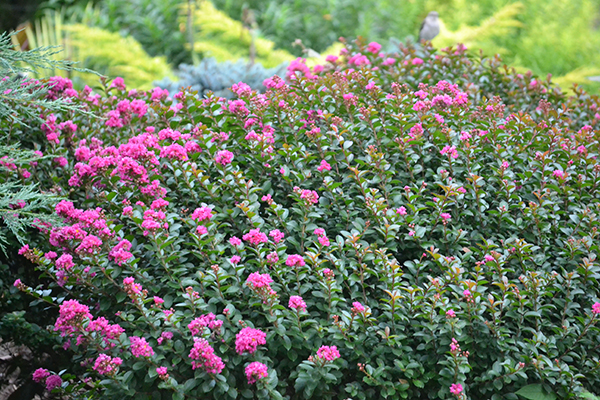UT Gardens August 2013 Plant of the Month: Common crapemyrtle
Known as the “Lilac of the South,” common crapemyrtle (Lagerstroemia indica) is truly a southern garden staple. It’s found in practically every southern landscape and adds multi-season interest to the garden. Depending on cultivar, the showy summer flowers bloom between late spring and early fall and flower colors range from white, pink, orchid, purple and dark red to true red. An added bonus, common crapemyrtle’s unique exfoliating bark and fall foliage color make it an alluring ornamental throughout the year.
Common crapemyrtles come in many different sizes to fit a variety of garden uses. With such an expansive selection, it is not difficult to find the desired color and size for your planting site. Dwarf cultivars such as ‘Pocomoke’ and ‘Cherry Dazzle’ grow less than five feet tall and are small enough to fit a small courtyard or city garden. They can also be used in containers or massed in borders.
Semi-dwarf cultivars grow five to 12 feet tall, intermediate cultivars grow 13 to 20 feet tall while tree varieties grow more than 23 feet tall. Intermediate cultivars and tree common crapemyrtles make excellent specimens near a patio or entryway. Tree types create gorgeous living arches and canopies over a driveway, walk or garden room. Site them where their summer blooms and winter exfoliating bark can also be enjoyed from indoors.
Whether multi– or single-stemmed, I suggest that the lower side branches of common crapemyrtle be removed as the plant grows to expose its gorgeous exfoliating bark. Though basal sucker growth can be a continual battle with common crapemyrtle, the plant’s durability and ornamental features make sucker maintenance worth the effort.
Common crapemyrtles do best in full to partial sun. They can take on the intense heat of summer and have moderate watering needs once mature. Common crapemyrtles are cold hardy from USDA hardiness zones 6 to 9 and can be killed back to the ground during a severe winter (-5 to -10 degrees Fahrenheit).
Ben Ford is a graduate student in public horticulture in the UT Institute of Agriculture Plant Sciences Department. He is also the HGTV intern for the UT Gardens, Knoxville. Designated as the official botanical garden for the State of Tennessee, the UT Gardens includes plant collections located in Knoxville, Jackson and Crossville. As part of the University of Tennessee Institute of Agriculture, the gardens’ mission is to foster appreciation, education and stewardship of plants through garden displays, educational programs and research trials. The gardens are open during all seasons and free to the public. For more information see http://utgardens.tennessee.edu.










